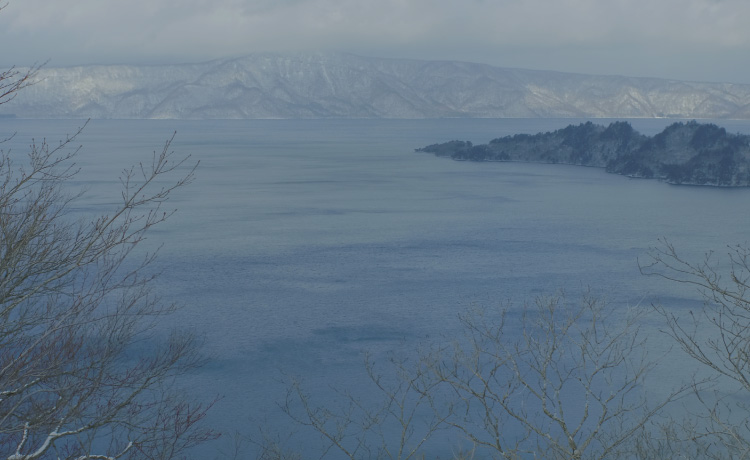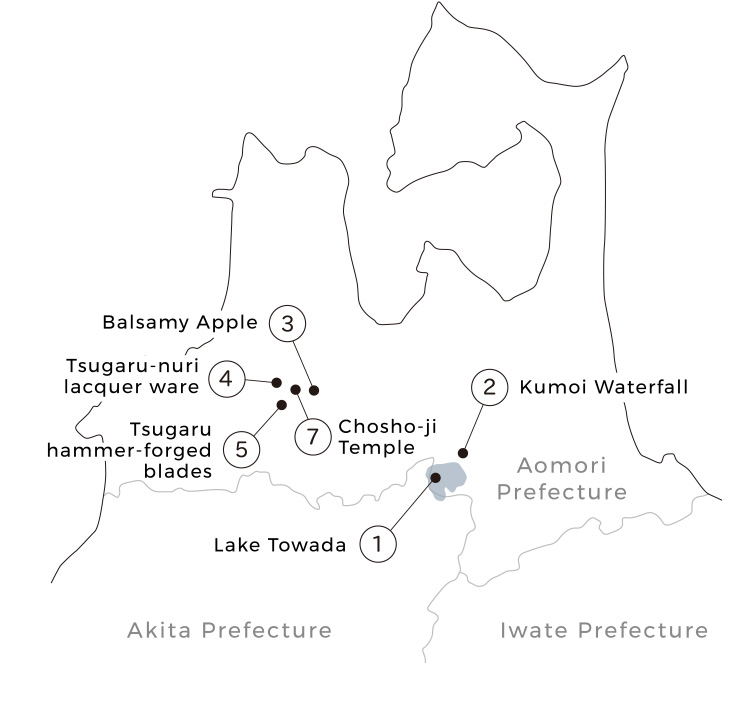



Summer is certainly fine, but winter holds a different kind of charm.
I explored the nature, architecture, and craftwork of Snow Country.



Lake Towada is a crater lake formed from a volcanic eruption. It straddles Aomori and Akita prefectures, with about three-fifths in the former and two- fifths in the latter. It is a very deep lake that does not freeze in winter. Although bustling with visitors during the peak recreation season from spring to fall, in the middle of winter, when mountain winds roughen its waves and thick snow and bitter cold descend, it is deserted. This world devoid of humans takes on a sort of divine beauty.

This magnificent waterfall flows into Oirase Stream. Water pours over a rock face separated into three sections from a height of 20 meters. Giant icicles hang off the half-frozen waterfall. The nearby mountain path is buried in knee-deep snow.
“Kumoi” means the feeling of being amongst the clouds. When you look at the water streaming out over the white snow, it really feels like you are standing amongst the clouds.

Looking at the row of oak barrels, you would think you’re in a whiskey warehouse, but instead they hold 100 percent balsamic vinegar made from Tsugaru apples. The apples’ subtle sweetness mixed with the vanilla notes that seep out of the wooden barrels after one to two years of aging create a novel flavor like no other. You can drizzle Basalmy Apple on your salad, but it’s just as delicious over ice cream!

Tsugaru-nuri is a lacquer ware technique that has been practiced since the Edo Period (1603–1868). Characterized by complex coloration and organic patterns, it can be found on a wide range of housewares used locally, from chopsticks to tables. Masakazu Kobayashi practices this traditional craft with a youthful flair. He made some custom-order button and accessories for me.

After the Meiji Restoration (1868) that ended feudal rule, the blacksmiths who had made samurai swords and guns turned to making pruning shears for apple trees and kitchen knives. Hammer-forged blades (uchihamono) became a traditional industry of Aomori. Go Yoshizawa is the eighth-generation head of Nigara Forging. I instantly fell in love with one of his paper knives! Its blade can cut like a Japanese sword and has beautiful wave-like patterns on it called anmon.

It’s as if I wandered into a church in the English countryside. This gothic red-brick church was built in 1920. Open its old-fashioned wood and metal doors, and you come to Japanese papered sliding doors at the entrance! Walk in farther, and you’ll enter a quaint Tudor-style chapel. The church still holds Sunday services as a house of the Lord.

As the family temple of the Tsugaru clan and housing the mausoleum of Tsugaru feudal lords, Chosho-ji Temple has a long and distinguished history. The large triple gate in front of the temple is 400 years old, and the priests’ living quarters draped in icicles is 500 years old. The temple has an austere rather than ornate feel, in keeping with the character of the people of Tsugaru.
職種:店舗販売 / 営業 / 生産管理 / パタンナー / デザイナー
正社員登用、給与は経験により相談。月20万円以上。
年齢性別不問。
厚生年金、健康保険、雇用保険等完備。交通費支給、賞与。
ご希望の方は、メールにて履歴書と職務経歴書をお送り下さい。
通過者のみ面接の返信をいたします。なお募集の職種は時期によって異なる場合があるのでお問い合わせください。
*学生のインターンは随時可能ですので、希望者は面接いたします。
送信先メールアドレス:matohu@lewsten.com
◇ matohuの理念
「日本の美意識が通底する新しい服の創造」をコンセプトに文化や歴史を大切にしながら、現代人の心に響く魅力ある「デザイン」を生み出すこと。それを深い「言葉」で表現し、共感者の輪を拡げて行く「場」を作って行くこと。
この3つを通して、多様で心豊かな世界をともに作り上げることがmatohuのプロジェクトであり、理念です。
◇ 仕事のやりがいと人間的成長
まかされた仕事を自分の創意で工夫していける環境です。1Fはショップ、2Fはアトリエになっており、デザイナーと直接話しながらアイデアを実現していけます。また文化、歴史など幅広い知識を学ぶ機会も多く大人の教養と礼儀が身につき、人間的にも成長できます。
人の心に彩りを添えるデザインを生活のなかに!を合い言葉にこれから世界に向けて発信するmatohuのスタッフを募集します。